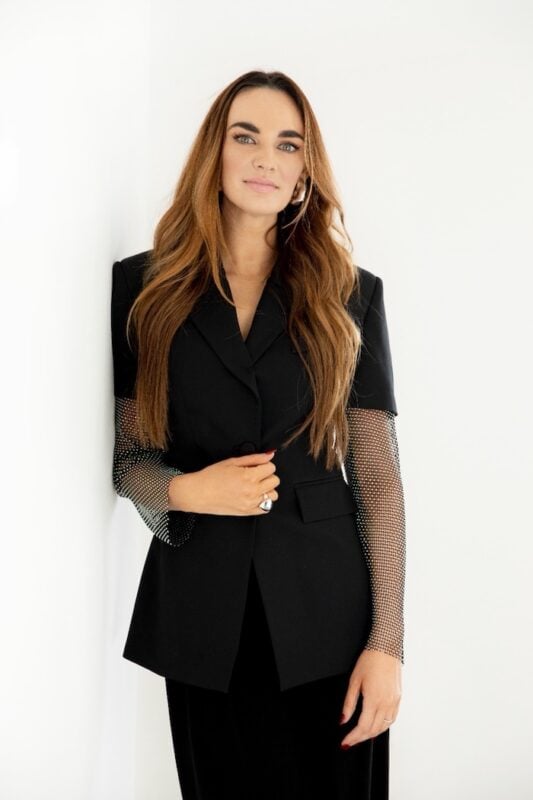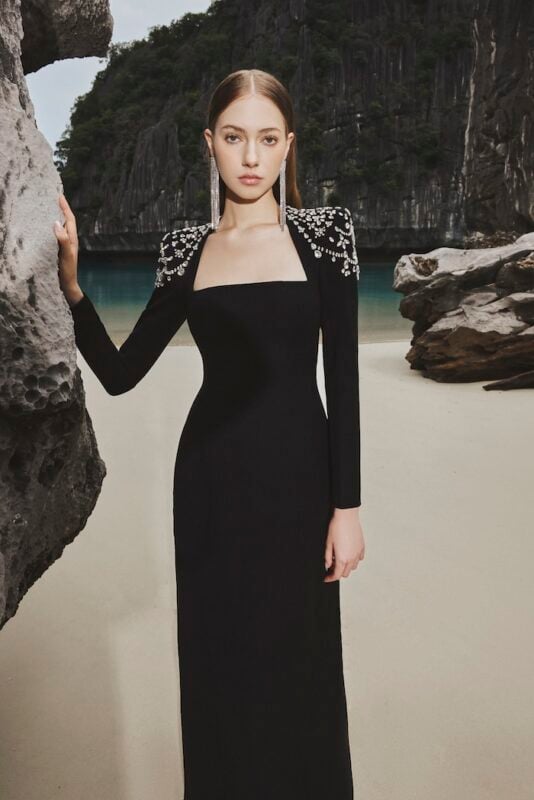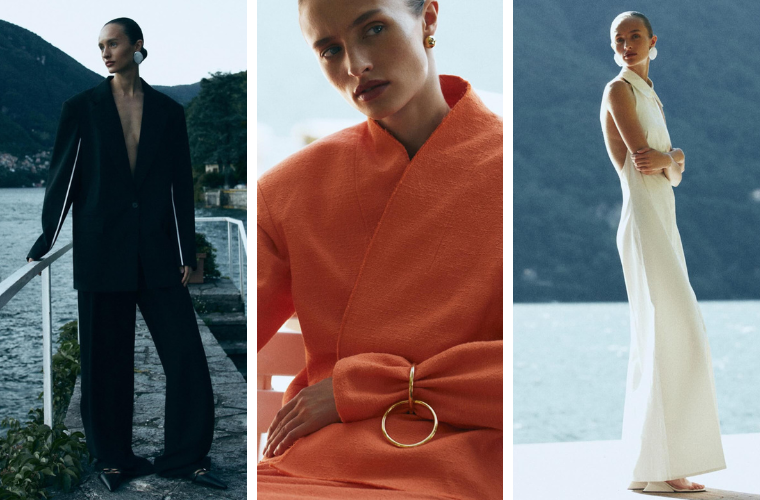In May’s Creativity & Commerce, Nina Briance, Founder and CEO of Cult Mia, on how creative thinking has landed her at the helm of a fast-growing online fashion marketplace of her own.
What do the first 30 minutes of your day look like, your morning routine?
From the moment my alarm goes off, I am fully on – I’ve learned to optimise my day to look after my two babies (my 10 month old daughter and Cult Mia!). I throw on my robe, some soothing eye patches and trot to the kitchen to prepare Isabella’s morning bottle and my first of many coffees of the day. These first 30 minutes are a special time in the day for me to spend with Isabella before kicking off my work schedule. I never check my phone during this small window as part of my ritual to find a balance between my personal and professional life.
What was the catalyst to launching Cult Mia? Tell us more about the concept.
When I look back, now that we’re four years in, there are three key lightbulb moments that sparked Cult Mia. First, when I was working at Moda Operandi, it became very clear to me that the model for online luxury fashion that had been so successful in the 2000s and 2010s was starting to lose steam. Simply getting access to luxury brands online was no longer a novelty: growth was stagnating, as shoppers began to desire more than just the aggregation of established brands. Simultaneously, the more I spoke with designers, the more I realised that many brands that were on the cusp of rapid growth were looking for space on a platform that would give them the spotlight with global visibility, rather than getting lost behind a multitude of product pages featuring the known luxury brands first. However, these designers were unable to access the existing platform, for a wide range of reasons, ranging from working capital challenges to meet inventory requirements or unsustainable marketing spends to be featured in high visibility customer touch points. Second, when I worked at the United Nations in the Women & Trade team, I noticed that the designs and products of the artisans that we supported were too frequently replicated or purchased with giving full credit to the original talent. The need to bolster independent fashion designers became glaringly obvious to me. Third, whenever anyone ever asked me about what I was wearing, it was never about my high street boots. Instead, it was always about my handmade enamel earrings from Mexico. I used to have to disappoint and say that you needed to travel to Oaxaca to get them.
Now, I can point you to Cult Mia: we connect independent fashion designers to our global luxury shoppers who seek exactly what our platform offers from a values perspective (sustainably sourced, ethically produced), as much as the product we sell (unique designs and a differentiated curation). We’re the only platform that brings you exclusive and independent luxury fashion from around the world, vetted for style, ethics and values. In terms of the buy, Cult Mia offers statement hero pieces.
What drove this decision creatively – was it a gap in the market or do you naturally gravitate towards this style?
Cult Mia is a marketplace, meaning we don’t buy or hold any inventory. This has allowed us to be very creative and agile with our curation and brand/product mix. We have vetted over 1,500 designers, testing a wide range of designs and categories, and delisting the collections that have not seen ample traction to keep the curation highly relevant for our shoppers. We’ve taken a data-driven and customer-centric approach when it came to refining our assortment and landing on a curation spearheaded by a standout product offering. We believe that ‘Cult Mia is no ordinary Cult. So why should your wardrobe be?’ Meaning that we do naturally gravitate towards this standout style and see-and-be-seen hero pieces as part of our business mission and USP, but we also have the data to tell us that there is clear appetite and a gap in the market to back this commercial decision.

NIna Briance, Founder and CEO at Cult Mia
How has thinking out-of-the-box serve you as an entrepreneur – have you always been able to think this way?
Thinking outside of the box is a key growth mindset for an entrepreneur: I am constantly look-ing at ways to push our boundaries and challenge our status quo. We’re still early in our journey and out-of-the-box thinking is central to remaining agile, lean, defensible and ahead of the competition.
I had a unique interdisciplinary mix of engineering, psychology and international relations in my course load while I was an undergraduate student at Stanford. Wearing various intellectual hats I believe taught me to think this way from an early age, combined with my first stint at entrepreneurship at the age of 19, which further cemented this way of thinking for me.
Which brands and pieces are driving sales in the Middle East – were there surprises or is this as predicted?
Dresses, and in particular evening wear, drive sales for Cult Mia in the Middle East. Three of the top performing designers last quarter in the region were Vietnamese couture-master Tracy Studio (the Long Sleeve Orchid Body-Con Dress has been hugely popular), UK-based, sustainable elegance by IHF (our Trapeze Dress with Shoulder Cape has been a favourite in green), and influencer- founded Deme by Gabriella (the Brown Draped Full Sleeves Gown in particular has flown off the shelves). Not many surprises in the brands and products at the top of the sales leaderboard: we’re seeing strong appetite for beautiful and well-constructed silhouettes, high-quality materials and finishings (a love for embellishments), along with modest covering (long sleeve floor length dresses).

What does it take to spot an independent talent or a great piece – is there a data-backed process or is it gut-led and instinctive?
The spotting of the unknown brands that deserve to be known is a combination of a criteria-driven, data-backed selection process and our partnerships (and my) instinctive taste for what is and will be on trend. Honing in on the Middle Eastern market scouting process, three data-led criteria that we consider are outlined below. Note that the selection process, including a much wider review from quality controls, to sustainability assessments, to name a few.
1. Category: Our Middle Eastern shoppers are predominately looking for pieces for events. We therefore hone in on occasionwear designers and focus on spotting top talent in evening wear, with a seasonal consideration for the warmer climate.
2. Style: Our Middle Eastern customer prefers long sleeve maxi dresses and gowns in black, gold, red/burgundy, beige. We look for designers offering these style and colour variants, as indicators for bestsellers.
3. Price: All selected pieces take into account our product price analysis by market. We select styles for the Middle East (conservative) at around Dhs2,761-Dhs9,172 (£600-£2,000) mark.
Then comes feeding in Cult Mia’s tastemaker opinion to make the final selection for which brands and products to list. More difficult to put down criteria for this on paper, we do have a ‘gut’ feeling for which designers will resonate best with our customer and will cut through the very crowded online fashion luxury landscape: this is where we see our standout and exclusive product offering shining through.

How do you balance both the creative and commercial sides of the business?
Planning for and creating the right structure to balance the business and creative sides of my work at Cult Mia has been hugely important and part of the recipe for the growth that we have seen to date. I have focused on setting clear goals, priorities and a workflow that has pre-planned blocks of time for innovative and creative thinking. I believe it’s so important that your goals must genuinely excite you, these are not laborious tasks, but a clear vision of something that will bring huge value and benefit into your life. Goals that you will continue to strive for, particularly when you hit obstacles and come up against challenges.
What are some of your personal favourite up and coming brands on your radar for SS24?
We launch new designers on the Cult Mia platform weekly, so it’s difficult to hand- pick a few! Here are my three latest designer obsessions going into spring:
Podyh: Ukrainian-born, architecturally-inspired RTW collection with fresh pastels and interesting textures.
Touchless: Bahrain-based hand- bags that combine the traditional touch of artisans with cutting-edge digital technologies and software. Innovative and original designs in spring tones – an exclusive capsule of bags in Cult Mia colours is in progress. Stay tuned!
Le Thanh Hoa: Not surprisingly and A-list favourite, exquisite Vietnamese eveningwear will be my go-to for spring and summer wedding guest dressing.

As an entrepreneur, how do you encourage creativity within your team and company culture?
I like to remind my team that while I’m the founder of Cult Mia, everyone in the team is an entrepreneur in their own right, during this building and rapid-scale phase of the business. Every week in our all-hands team meeting, we have a joint blue sky brainstorming session, with the prompt to think creatively on how to unblock barriers, speed up growth, improve the customer experience and so on. An open and trusted forum amongst the team is key to encouraging creativity, while maintaining a mindset that we can always improve on what we have already built.
This is The Creativity Issue – what do you associate with that term?
Creativity to me within the business context of Cult Mia is about inspiring my team, innovative problem-solving and the discovery of opportunities where others have not been.
– For more on luxury lifestyle, news, fashion and beauty follow Emirates Woman on Facebook and Instagram
May’s – The Creativity Issue with Tiffany & Co. – Download Now
Images: Supplied










